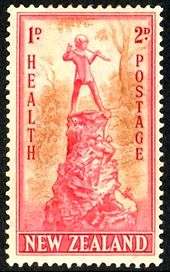Semi-postal stamp
_Jugendmarke_1972_60_Pf.jpg)
A semi-postal stamp or semipostal stamp, also known as a charity stamp, is a postage stamp issued to raise money for a particular purpose (such as a charitable cause) and sold at a premium over the postal value.[1] Typically the stamp shows two denominations separated by a plus sign, but in many cases the only denomination shown is for the postage rate, and the postal customer simply pays the higher price when purchasing the stamps.
The first semi-postals
The first semi-postal was actually a postal card; to commemorate the Uniform Penny Post in 1890, the United Kingdom of Great Britain and Ireland issued a card with a face value of one penny, but sold it for sixpence, with the difference given to a fund for postal workers. The first semi-postal stamps were issued by the Australian colonies of New South Wales and Victoria, who both marked the Diamond Jubilee of Queen Victoria in 1897 with stamps denominated in pennies, but sold for shillings, a 12x increase over the face value.
Twentieth century issues

Semi-postals became widespread in European countries at the beginning of the 20th century. In many cases they have become standard annual issues, such as the Pro Juventute series of Switzerland started in 1913. Many countries issued semi-postal stamps to raise money for the Red Cross in World War I. The surcharges are typically a fraction of the face value; at one point the Fédération Internationale de Philatélie was officially boycotting stamps with surcharges greater than 50 per cent of face value, saying that such issues were exploitive of stamp collectors. The United Kingdom's Royal Mail, a relative newcomer to semi-postals, issued its first stamp of this type in 1975 with a 4½p denomination and a premium of 1½p for charitable causes making the total cost 6p, with funds going to health and handicap charities. The stamp issue was not considered a success and there have been few UK semi-postal issues since.
Some non-European countries followed suit (such as New Zealand, which has issued health stamps annually since 1929); the New Zealand associated territories of the Cook Islands and Niue often issue Christmas or Easter stamps in two sets of values, with one set having a charitable surcharge. But semi-postal stamps are still predominantly European. By contrast, the United States is a newcomer to semi-postals, with its first semi-postal being the Breast cancer research stamp issued in July 1998. As of 2014 four additional stamps were issued, three for other causes and the fourth a reissue of the Breast cancer stamp.
Semi-postal issues are not always issued on a regular basis for health and similar causes; they have been on occasion issued as a means of raising funds for disaster relief. These are usually sold as charity stamps, though occasionally, as with the 1971 refugee relief stamps of India, the excess cost has been levied as an obligatory tax. One of the highest value semi-postal stamps is the Falkland islands' "rebuilding fund" stamp, issued in 1982 after the Anglo-Argentinian war over the islands. This was aimed primarily at collectors, and had a postal value of £1 with an added £1 surcharge.
Charitable disaster relief stamps are commonly found in smaller island nations as a result of natural disasters, as in the case of St. Vincent and the Grenadines' 1980 hurricane relief issues, and Tonga's 1982 cyclone relief stamp. In these cases, existing issues are often used, overprinted with text indicating the reason for the surcharge.
See also
References and sources
- Notes
- ↑ Mackay, James (2003). Philatelic Terms Illustrated, 4th edition. London: Stanley Gibbons. p. 26. ISBN 0-85259-557-3.
- Sources
- Richard McP. Cabeen, Standard Handbook of Stamp Collecting (Harper & Row, 1979), pp. 455–457 ISBN 0-690-01773-1
External links
| Wikimedia Commons has media related to Semi-postal stamps. |